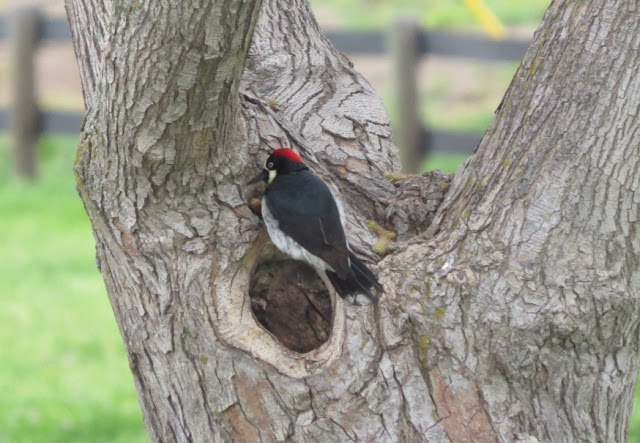I had never seen a Giant Sequoia (or any size Sequoia) before, so this day's goal was to drive up into the National Forest to find one. The day before was too blustery, so I used that day to go to AutoZone and buy chains to carry, so I could go beyond that "must carry" sign to the elevations where the big trees grow. The nice thing about buying chains instead of renting them is that if I don't have to use them, I can return them for a full refund after I'm done visiting Yosemite. (Bought for both the car and RV for the trip into Yosemite.)
Next I visited the National Forest Ranger Station for information and maps about where I could access one of the Giant Sequoia Groves. So Thistle and I were all set!
But first some pictures from the campground...wild flowers on our morning walk:
Last fall I watched Acorn Woodpeckers storing acorns in a telephone pole in Fort Davis, Texas. Today I got to watch a couple of woodpeckers harvesting an acorn from the tree by my site. This is the female pecking hard to dislodge the acorn. She did all the work.
Then the male shows up and the female abandons the acorn.
I thought when I took this picture that the male was snatching her acorn, but watch...
The acorn is still there...it was a bug or something else he got! Later I noticed the acorn was gone with only its empty shell on the ground, so I don't know which woodpecker got it.
To get to the mountains, you drive through the historic town of Springville on CA 190. I did not have time this trip to stop and tour this interesting-looking town.
On the way up I noticed this aqueduct snaking down the mountain.
I forgot to ask the rangers for more information about that.
No place to stop on this switchback for a better photo, but there is a waterfall behind that blooming redbud tree.
I did stop at a pull-off to get these shots of a nice waterfall on the Tule River.
My goal was to walk the Camp Nelson Trail through a Giant Sequoia grove. I stopped to ask directions at a cafe in Pierpoint Springs. I was very surprised to see a thriving community at this elevation.
View from Camp Nelson.
The trail starts a little beyond this still-closed National Forest Campground. The advice was to park and walk from here.
I hiked through the McIntyre Grove, about halfway to the end of the trail at Quaking Aspens.
There are a few private camps along the road to the trailhead.
Thistle is not sure what was guarding this camp.
Some kind of Giant Sequoia monster, I guess.
There were a few impressive Sequoias in this area.
And pretty gurgling brooks.
The nice difference between the National Forest and the Sequoia National Park I'll go to next is that Thistle is allowed on the trails in the Forest, but not in the Park. So we enjoyed while we could.
As we climbed, we began to see more sequoias.
And soon we saw larger ones.
I was pretty sure we were entering the McIntyre Grove, although no signs confirmed it.
And there were patches of snow...we were at about 6,000 feet, I think.
Now this has to qualify as a Giant Sequoia, although I don't know the criteria that separates an average sequoia and a giant one.
Thistle was a bit intimidated by it, and chose a smaller tree to lift his leg on.
He did get curious enough to sniff that hollow area.
Oh wow.
Amazing place, and the trail all to ourselves. Another advantage over the more popular National Park destinations. But I'll do both.
The wide base of a Giant Sequoia.
There was steam rising off this log...interacting with the chilly air.
Moss growing on a downed tree.
We turned around at this bridge...not that we were afraid to cross it, but it was time.
We saw many more Giants in this grove.
About the only thing that kills one of these trees is when it topples due to its shallow root system. You don't want to be around when one of these trees falls.
Roots of a downed Sequoia.
And I don't want to leave out all the other beautiful tall trees sharing this forest with the Sequoias.
One more stop the lady at the cafe told me about...the soda springs.
Locals use the soda water from this spring in their pancakes and biscuits.
This stone tells a little history about the community of Camp Nelson. You may have to enlarge it to read it.








































